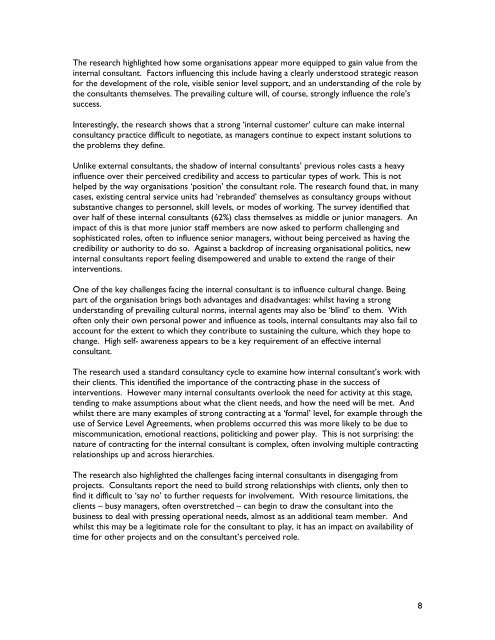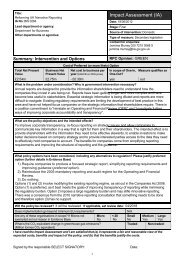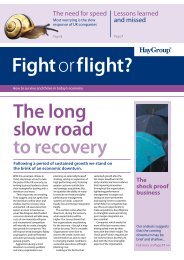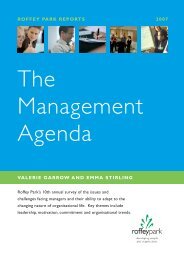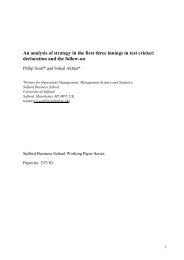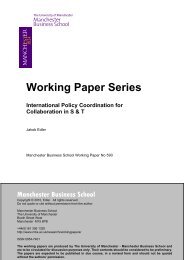The Role of the Internal Consultant - Management & Business ...
The Role of the Internal Consultant - Management & Business ...
The Role of the Internal Consultant - Management & Business ...
- No tags were found...
You also want an ePaper? Increase the reach of your titles
YUMPU automatically turns print PDFs into web optimized ePapers that Google loves.
<strong>The</strong> research highlighted how some organisations appear more equipped to gain value from <strong>the</strong>internal consultant. Factors influencing this include having a clearly understood strategic reasonfor <strong>the</strong> development <strong>of</strong> <strong>the</strong> role, visible senior level support, and an understanding <strong>of</strong> <strong>the</strong> role by<strong>the</strong> consultants <strong>the</strong>mselves. <strong>The</strong> prevailing culture will, <strong>of</strong> course, strongly influence <strong>the</strong> role’ssuccess.Interestingly, <strong>the</strong> research shows that a strong ‘internal customer’ culture can make internalconsultancy practice difficult to negotiate, as managers continue to expect instant solutions to<strong>the</strong> problems <strong>the</strong>y define.Unlike external consultants, <strong>the</strong> shadow <strong>of</strong> internal consultants’ previous roles casts a heavyinfluence over <strong>the</strong>ir perceived credibility and access to particular types <strong>of</strong> work. This is no<strong>the</strong>lped by <strong>the</strong> way organisations ‘position’ <strong>the</strong> consultant role. <strong>The</strong> research found that, in manycases, existing central service units had ‘rebranded’ <strong>the</strong>mselves as consultancy groups withoutsubstantive changes to personnel, skill levels, or modes <strong>of</strong> working. <strong>The</strong> survey identified thatover half <strong>of</strong> <strong>the</strong>se internal consultants (62%) class <strong>the</strong>mselves as middle or junior managers. Animpact <strong>of</strong> this is that more junior staff members are now asked to perform challenging andsophisticated roles, <strong>of</strong>ten to influence senior managers, without being perceived as having <strong>the</strong>credibility or authority to do so. Against a backdrop <strong>of</strong> increasing organisational politics, newinternal consultants report feeling disempowered and unable to extend <strong>the</strong> range <strong>of</strong> <strong>the</strong>irinterventions.One <strong>of</strong> <strong>the</strong> key challenges facing <strong>the</strong> internal consultant is to influence cultural change. Beingpart <strong>of</strong> <strong>the</strong> organisation brings both advantages and disadvantages: whilst having a strongunderstanding <strong>of</strong> prevailing cultural norms, internal agents may also be ‘blind’ to <strong>the</strong>m. With<strong>of</strong>ten only <strong>the</strong>ir own personal power and influence as tools, internal consultants may also fail toaccount for <strong>the</strong> extent to which <strong>the</strong>y contribute to sustaining <strong>the</strong> culture, which <strong>the</strong>y hope tochange. High self- awareness appears to be a key requirement <strong>of</strong> an effective internalconsultant.<strong>The</strong> research used a standard consultancy cycle to examine how internal consultant’s work with<strong>the</strong>ir clients. This identified <strong>the</strong> importance <strong>of</strong> <strong>the</strong> contracting phase in <strong>the</strong> success <strong>of</strong>interventions. However many internal consultants overlook <strong>the</strong> need for activity at this stage,tending to make assumptions about what <strong>the</strong> client needs, and how <strong>the</strong> need will be met. Andwhilst <strong>the</strong>re are many examples <strong>of</strong> strong contracting at a ‘formal’ level, for example through <strong>the</strong>use <strong>of</strong> Service Level Agreements, when problems occurred this was more likely to be due tomiscommunication, emotional reactions, politicking and power play. This is not surprising: <strong>the</strong>nature <strong>of</strong> contracting for <strong>the</strong> internal consultant is complex, <strong>of</strong>ten involving multiple contractingrelationships up and across hierarchies.<strong>The</strong> research also highlighted <strong>the</strong> challenges facing internal consultants in disengaging fromprojects. <strong>Consultant</strong>s report <strong>the</strong> need to build strong relationships with clients, only <strong>the</strong>n t<strong>of</strong>ind it difficult to ‘say no’ to fur<strong>the</strong>r requests for involvement. With resource limitations, <strong>the</strong>clients – busy managers, <strong>of</strong>ten overstretched – can begin to draw <strong>the</strong> consultant into <strong>the</strong>business to deal with pressing operational needs, almost as an additional team member. Andwhilst this may be a legitimate role for <strong>the</strong> consultant to play, it has an impact on availability <strong>of</strong>time for o<strong>the</strong>r projects and on <strong>the</strong> consultant’s perceived role.8


